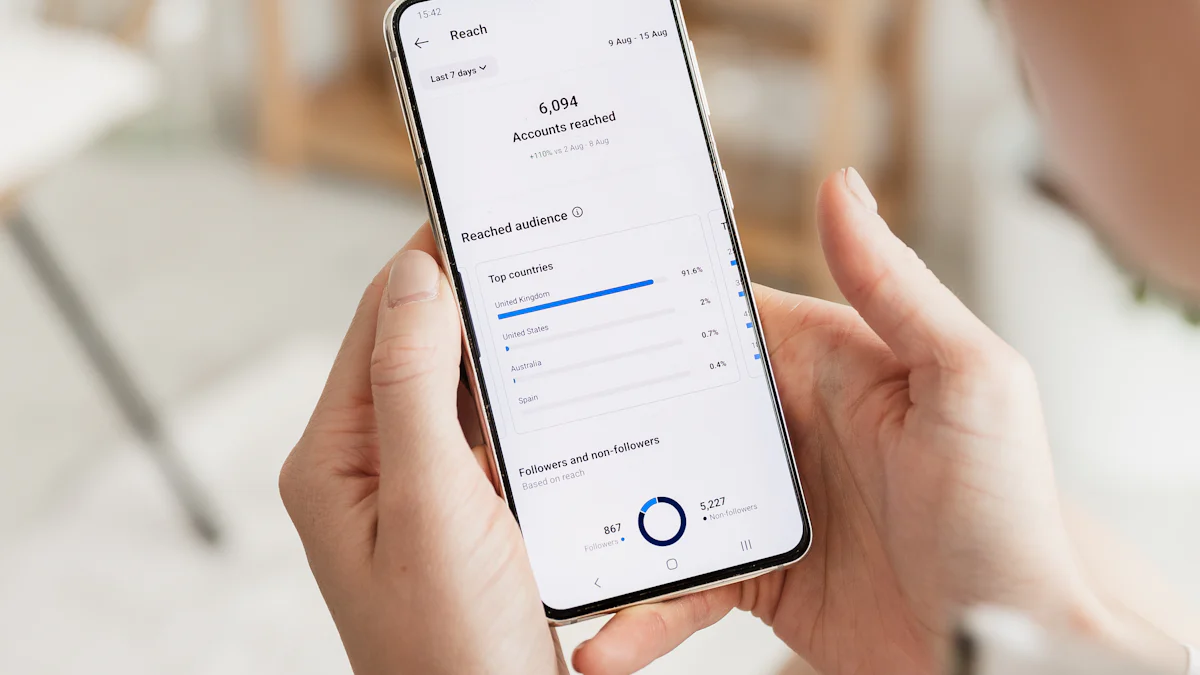Mastering Inventory Management with Push and Pull Strategies

In the realm of inventory management, understanding push and pull strategies is crucial. The inventory full push strategy involves producing goods in anticipation of demand, allowing you to stock products ahead of time. Conversely, the pull strategy focuses on producing goods based on actual customer demand, minimizing excess inventory and reducing holding costs. Choosing the right strategy can significantly enhance business efficiency. By carefully considering your organizational needs and customer demands, you can optimize your supply chain for better results.
Key Takeaways
Understand the difference between push and pull strategies: Push strategies involve producing goods in anticipation of demand, while pull strategies focus on producing based on actual customer orders.
Choose the right strategy based on demand predictability: If demand is stable, a push strategy may be effective; if unpredictable, consider a pull strategy to minimize excess inventory.
Leverage the benefits of economies of scale with push strategies: Producing in bulk can reduce costs and ensure product availability during peak demand periods.
Reduce waste and holding costs with pull strategies: By producing only what is needed based on customer demand, you can maintain lean inventory and adapt to market changes.
Consider a hybrid approach for flexibility: A push-pull hybrid strategy allows you to stock essential items while responding to specific customer orders, optimizing your supply chain.
Utilize technology to enhance inventory management: Tools like JUSDA's Warehouse Solutions can help integrate push and pull strategies for improved efficiency.
Evaluate your production and storage capabilities: Ensure your chosen strategy aligns with your operational strengths to maximize efficiency and competitiveness.
Understanding Push and Pull Strategies

What is a Push Strategy?
A push strategy in inventory management involves producing goods in anticipation of demand. You stock products ahead of time, ensuring availability when customers need them. This approach often suits industries with predictable demand patterns. For example, companies like Coca-Cola use push strategies to ensure their products are always available on store shelves.
Definition and key characteristics
In a push strategy, you focus on forecasting demand and producing goods accordingly. This method allows you to benefit from economies of scale by manufacturing large quantities at once. It also helps in maintaining a steady production schedule, reducing the risk of stockouts. However, it requires accurate demand forecasting to avoid overproduction and excess inventory.
Examples of industries using push strategies
Industries such as electronics and consumer goods often rely on push strategies. For instance, manufacturers of household appliances produce items based on anticipated seasonal demand. This ensures that products are readily available during peak shopping periods. Additionally, companies like Apple utilize push strategies to launch new products, ensuring sufficient stock for initial high demand.
What is a Pull Strategy?
A pull strategy focuses on producing goods based on actual customer demand. You minimize excess inventory and reduce holding costs by responding directly to what customers want. This approach is particularly beneficial for products with unpredictable demand patterns.
Definition and key characteristics
In a pull strategy, production begins only after receiving customer orders. This method reduces waste and allows for more precise inventory control. You can adapt quickly to changes in consumer preferences, ensuring that you meet current market demands. However, it may lead to longer lead times if not managed efficiently.
Examples of industries using pull strategies
Industries with highly variable demand, such as fashion and technology, often adopt pull strategies. For example, custom clothing manufacturers produce garments based on specific customer orders, minimizing excess stock. Similarly, tech companies may use pull strategies for products with rapidly changing features, ensuring they meet the latest consumer needs.
Advantages and Disadvantages of Push and Pull Strategies
Pros and Cons of Push Strategy
Advantages such as economies of scale
Using a push strategy in inventory management offers several benefits. One of the most significant advantages is the ability to achieve economies of scale. By producing goods in large quantities, you can reduce the cost per unit. This approach allows you to maintain a steady production schedule, which can lead to more efficient use of resources. Additionally, having products readily available can help you quickly meet customer demand, enhancing your brand's visibility and ensuring that your products are always on hand when needed.
Disadvantages like overproduction risks
However, the push strategy also comes with its challenges. The reliance on demand forecasts means that inaccuracies can lead to overproduction. When you produce more than what is needed, you risk accumulating excess inventory, which can increase holding costs and tie up capital. This situation can lead to waste and inefficiencies, especially if the products become obsolete or if market demand shifts unexpectedly. Therefore, while the push strategy can provide immediate visibility, it requires precise forecasting to avoid these pitfalls.
Pros and Cons of Pull Strategy
Advantages such as reduced waste
The pull strategy offers a different set of advantages. By focusing on actual customer demand, you can significantly reduce waste. This approach allows you to produce only what is needed, minimizing excess inventory and reducing holding costs. You can respond more flexibly to changes in consumer preferences, ensuring that your products align with current market trends. This strategy fosters a more sustainable approach to inventory management, as it emphasizes efficiency and adaptability.
Disadvantages like potential stockouts
Despite its benefits, the pull strategy has its drawbacks. One of the main challenges is the potential for stockouts. Since production begins only after receiving customer orders, there might be delays in fulfilling demand, especially if the supply chain is not agile enough. This can lead to longer lead times and may affect customer satisfaction if they have to wait for their orders. While the pull strategy helps build customer loyalty by aligning closely with their needs, it requires a robust system to manage orders efficiently and prevent stockouts.
Choosing the Right Strategy for Your Business
Selecting the appropriate supply chain strategy is crucial for your business's success. You must evaluate several factors to determine which approach aligns best with your operational goals and market conditions.
Factors to Consider
Market demand predictability
Understanding market demand predictability is essential when choosing a supply chain strategy. If you can accurately forecast demand, a push strategy might suit your needs. This approach allows you to produce and stock products in advance, ensuring availability during peak periods. However, if demand is unpredictable, a pull strategy may be more effective. This method enables you to respond directly to customer orders, reducing the risk of excess inventory.
Production and storage capabilities
Your production and storage capabilities also play a significant role in determining the right supply chain strategy. A push strategy requires substantial storage space to accommodate large quantities of pre-produced goods. You need efficient production facilities to maintain a steady output. Conversely, a pull strategy demands flexibility in production processes. You must adapt quickly to changing customer demands, which may require agile manufacturing systems and just-in-time inventory management.
Examples of Successful Strategy Implementation
Case study of a company using push strategy
Consider a leading beverage company that successfully implemented a push strategy. By forecasting seasonal demand, the company produced and stocked beverages ahead of time. This approach ensured product availability during high-demand periods, such as summer and holidays. The company leveraged economies of scale, reducing production costs and enhancing profitability. Their supply chain strategy focused on maintaining a consistent production schedule, which minimized disruptions and maximized efficiency.
Case study of a company using pull strategy
A renowned fashion retailer provides an excellent example of a successful pull strategy. The retailer responded to real-time customer preferences by producing garments based on actual orders. This approach minimized excess inventory and reduced holding costs. The company utilized advanced data analytics to track consumer trends, allowing them to adjust their product offerings swiftly. Their supply chain strategy emphasized adaptability and responsiveness, ensuring they met customer expectations while maintaining lean operations.
By carefully considering these factors and examining successful implementations, you can choose a supply chain strategy that optimizes your business operations. Whether you opt for a push, pull, or hybrid approach, aligning your strategy with your capabilities and market demands will enhance your overall efficiency and competitiveness.
Exploring a Push-Pull Hybrid Approach

In the dynamic world of inventory management, a push-pull hybrid strategy offers a balanced approach. By combining elements of both the push system and pull strategies, you can leverage the strengths of each to optimize your supply chain.
What is a Push-Pull Hybrid Strategy?
A push-pull hybrid strategy integrates the proactive nature of the push system with the reactive flexibility of the pull strategy. In this approach, you produce and stock certain products in anticipation of demand, while others are manufactured based on actual customer orders. This combination allows you to maintain a steady supply of staple items while remaining agile enough to respond to fluctuating market demands.
Combining elements of both push and pull
The push-pull hybrid strategy involves using the push system for products with stable demand and the pull strategy for items with unpredictable demand. For example, you might use the push system to stock essential goods that customers consistently purchase. Meanwhile, you can apply the pull strategy to customize products based on specific customer preferences. This dual approach helps you manage inventory more effectively, reducing waste and improving customer satisfaction.
Benefits of a Hybrid Approach
Adopting a push-pull hybrid strategy offers several advantages that enhance your inventory management capabilities.
Flexibility and adaptability
The push-pull hybrid strategy provides flexibility and adaptability, allowing you to adjust your production and inventory levels based on real-time data. By combining the predictability of the push system with the responsiveness of the pull strategy, you can better align your operations with market trends. This adaptability ensures that you meet customer demands efficiently, minimizing the risk of stockouts or overproduction.
Case study of a successful hybrid strategy
Consider a leading electronics company that successfully implemented a push-pull hybrid strategy. The company used the push system to produce and stock popular electronic devices, ensuring availability during peak sales periods. Simultaneously, they employed the pull strategy for custom orders, allowing customers to personalize their products. This approach enabled the company to maintain a robust supply chain while offering tailored solutions to meet diverse customer needs.
By integrating the push-pull hybrid strategy into your inventory management practices, you can achieve a harmonious balance between efficiency and responsiveness. This approach not only optimizes your supply chain but also enhances your ability to adapt to changing market conditions, ultimately driving business success.

JUSDA Solutions
To provide you with professional solutions and quotations.
Selecting the right strategy for effective inventory management is crucial. You must weigh the benefits of the inventory full push and pull strategy to align with your business needs. The pull system allows you to respond directly to customer demand, minimizing excess inventory and reducing holding costs. Meanwhile, the inventory full push strategy ensures product availability through demand forecasting. Leveraging technology, such as JUSDA's Warehouse Solutions, can optimize your supply chain management. With nearly 20 years of experience, JUSDA enhances inventory fulfillment by integrating the pull system and pull strategy, ensuring your supply chain remains competitive and efficient.
See Also
Essential Strategies for Successful Supply Chain Optimization
Boost Your Business Using Innovative Inventory Strategies
Discover 5 Cutting-Edge Techniques for Supply Chain Success
Expert Insights on Effective Risk Management in Supply Chains
Transforming Warehouse Efficiency with Logistics Robotics Technology
